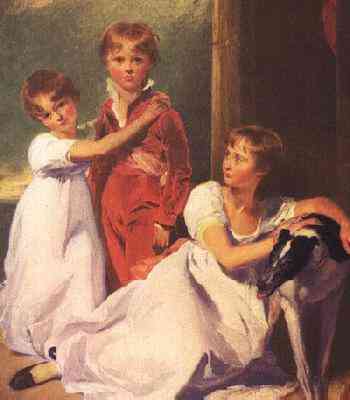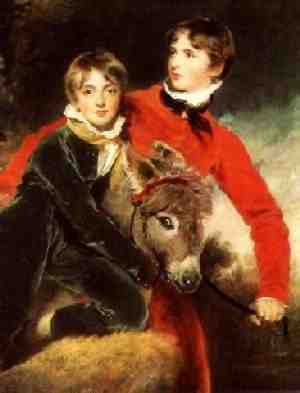
Ruffled Collars: The Early 19th Century

Figure 2.--Classic skeleton suits at the turn of the century were commonly worn with large, open-necked ruffled collars. This 1805 painting by Sir Thomas Lawrence shows the Fluyden children. The pose suggests
the child at the left is a girl, but boys of that age would be dressed identically with their sisters.
|
Ruffled collars were all the rage for men and boys at the turn og the 19th century. France had been the major arbriter for European fashions for two centurirs, but did not end the French influence. The French Revolutiin (1789) affected this. Ruffles were still widely used for boys in Regency (British) and Empire (French) fashions during the late 18th and early 19th centuries. The style was also worn by American boys, particularly in the eastern cities. The style endured for a considerable period of time.
Collar Styles
Boys wore different styles of ruffled collars, but the can be roughly classified into two different styles.
Open style
The ruffled collar most popular at the turn of the century was a open, comfortable looking fashion. Styles and sizes varied considerably, but some were quite large and flouny--insome cases extending well down
the front of the blouse. These open-styled ruffled collars were, of course worn without bows. The open-collar fashion appeared to be a style well suited for children as it looks like a comfortable and non-restricting style. It was extremely popular and worn bybboys througout Europe. It is also a classic example of how fashions change. The comfortable open collar sdtyle is in stark contrast to the formal more restrictive styles adopted by the Victorians for the larger ruffled worn by boys in the later 19th and early 20th Centuries.

Figure 2.--Lawrence painted these two brothers in velvet suits, but I'm unsure about the dates. Note the
more formal-looking, high ruffled collars and small, rather informal neck ribbons.
|
Closed style
Some boys are pictured in more formal looking, closed ruffled collars. The collars were closed and worn much higher than the open-collar style. These collars were also worn with skeleton suits or by the 1820s suits
similar to skeleton suits, but without the high waists and elaborate buttons on the jackets and pants. I'm not sure precisely when these high, closed collars were worn. More than likely at about the same
time as those high collars were popular during the Regency period. These closed ruffled collars
were usually smaller than the open-style and were worn with small bows. I think this closed-collar style for boys appeared about the 1820s, but as yet have
information to confirm this. The style was often worn as a high collar, which was a characteristic of men's Regency fashions--but much higher collars and with less ruffled material than those for boys.
Garments
The most common kind of garments
worn with ruffled collars was initially the
knee breeches worn by men and boys in the 18th century. At the end of the 18th century styles began to change and open ruffled collars were often worn with:
skeleton suits,
tunics, and smocks. These garments were widely worn in the first three decades of the 19th century.
Dresses
Young boys and girls in the 19th century were often dressed alike in dresses. At the beginning of the decade boys and girls dresses were undistinguishable--except perhaps little features such as the color of the sash. Dresses in the early part of the decade were comfortable and unrestructing. Many were open necked without any collar at all.
As the 19th Century progressed, the collar on children's dresses were sometimes used to diferentiate boys from girls. Often the girls neckline might be cut lower while boys might have higher even though fancy collars. There were no definite rules on such matters,
however, and mostly it was up to the fancy of the mothers.
Skeleton suits
The ruffled collars boys wore with knee breeches and jackets during the 17th century were simply incorporated into the increasingly popular skeleton suits. Almost all boys by the 1790s were wearing their skeletton suits with long trousers and few boys were seen in knee breeches after the turn of the 19th cebntury. Open collared blouses with
ruffled collars were the most common blouse worn with skeleton suits. Many of the blouses had quite large ruffled collars. The 18th Century skeleton suits can usually be destinguished from 19th Century suits as skeleton suits were intially made with
knee breeches and only began to be worn with long trousers after the turn of the century. Thus the blouses and ruffled collars can usually be dated.
Christopher Wagner
histclo@lycosmail.com
Navigate the Boys' Historical Clothing Web Site:
[Return to the Main ruffled collar chronology page]
[Return to the Main collar page]
[Introduction]
[Activities]
[Bibliographies]
[Biographies]
[Chronology]
[Clothing styles]
[Contributions]
[Countries]
[FAQs]
[Boys' Clothing Home]
Created: March 12, 1998
Last updated: March 10, 2000



